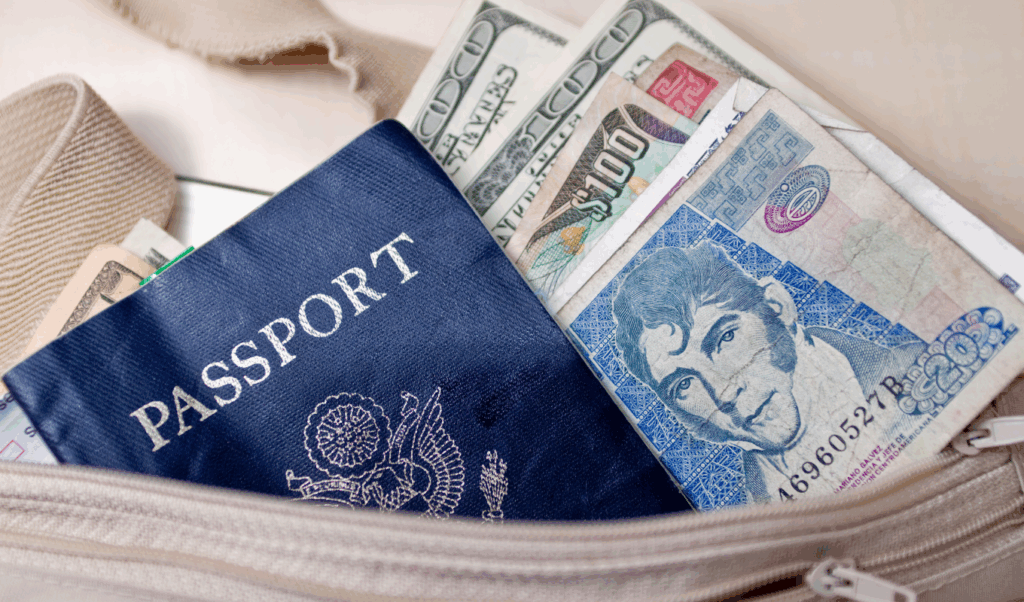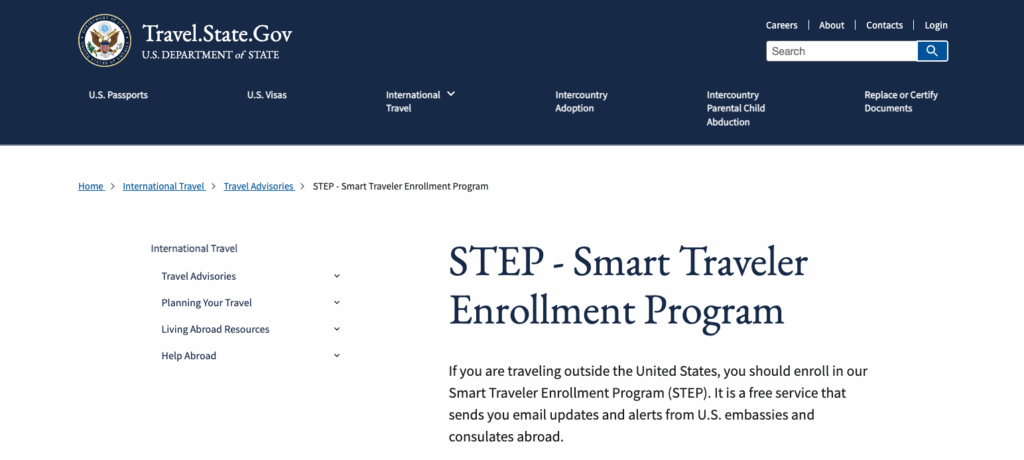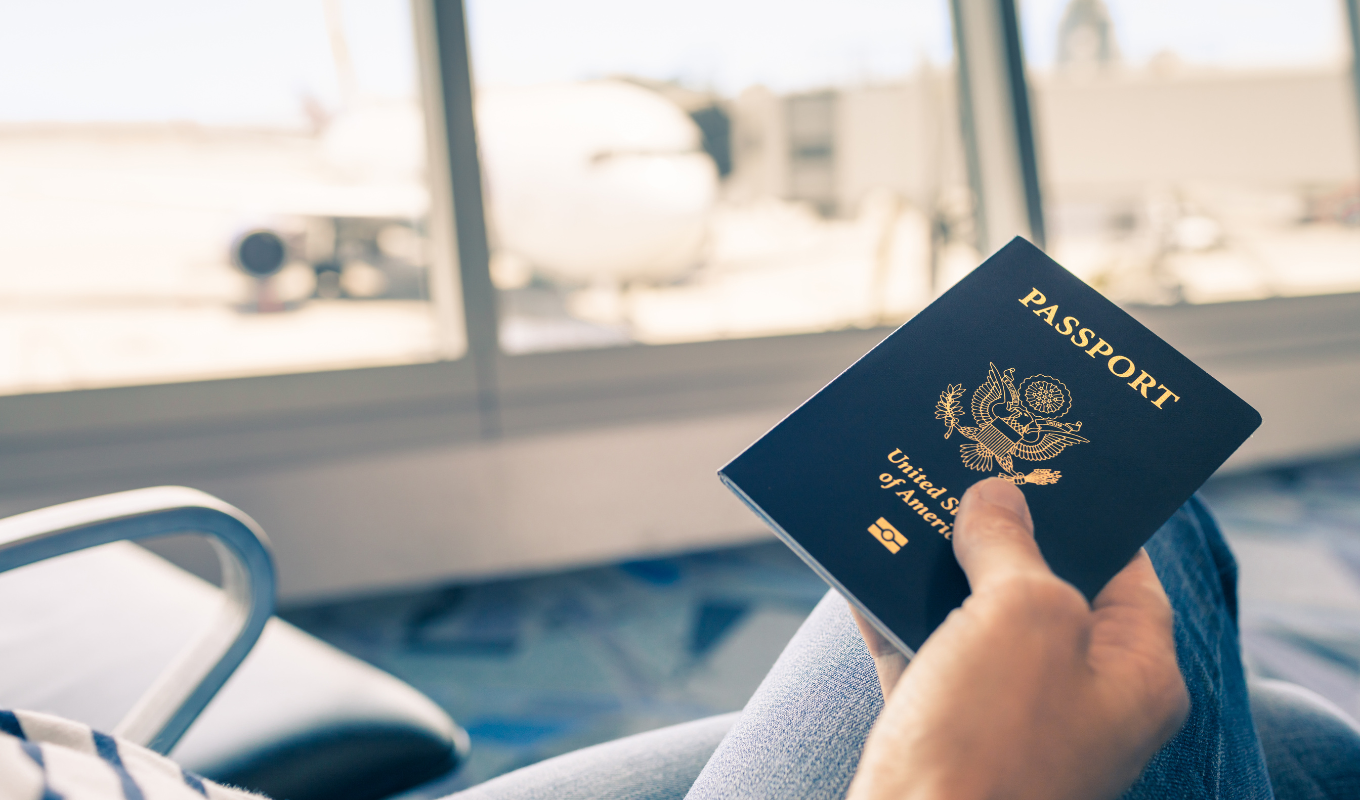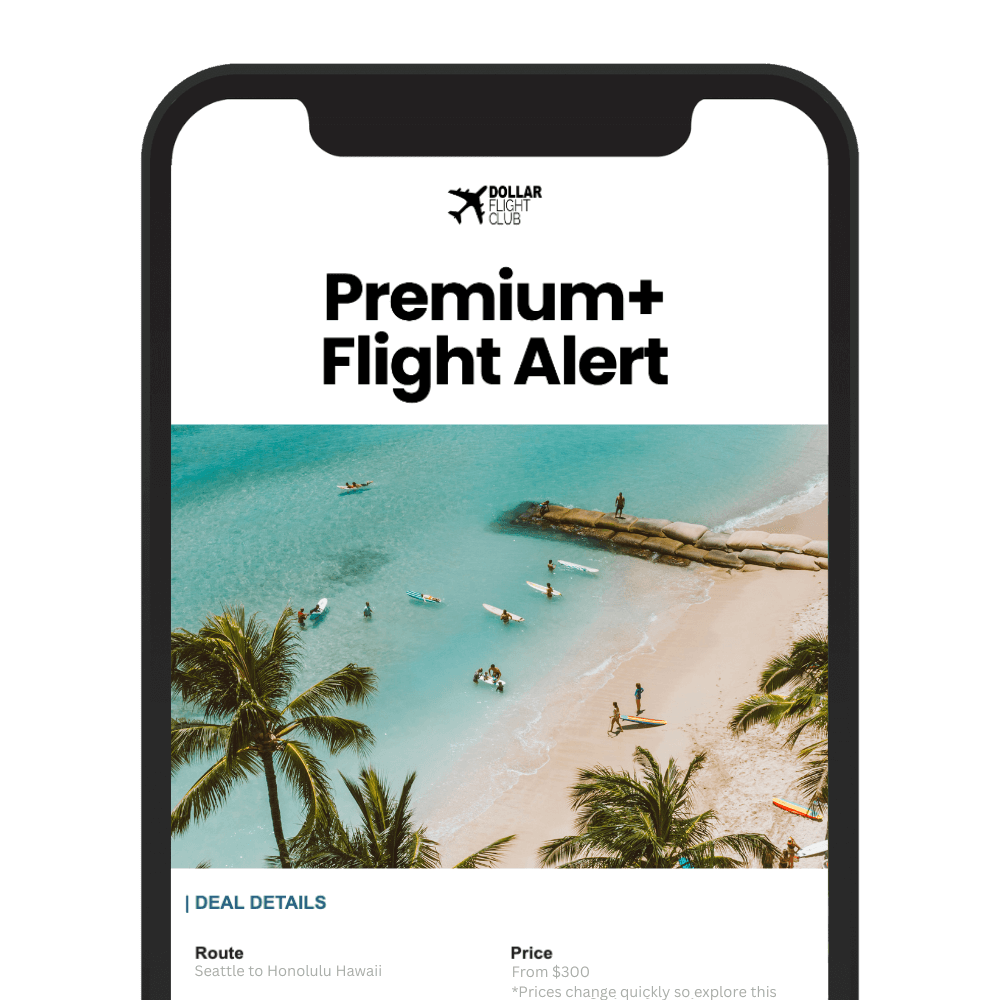Your passport is your most important travel document. Losing it or having it stolen can disrupt your trip, lead to identity theft, and cause significant stress. Here’s how to keep your passport safe:
- Store it securely: Use a hotel safe, money belt, neck pouch, or secure travel bag. Avoid easily accessible spots like back pockets or open bags.
- Make backups: Carry physical and digital copies of your passport. Upload a copy to a secure cloud service and email it to yourself for easy access.
- Prevent damage: Use a passport cover and waterproof pouch to protect it from wear, spills, and weather. Keep it away from heat and sunlight.
- Stay alert: Be cautious in crowded areas like airports and tourist spots. Handle your passport discreetly and secure it immediately after use.
- Know what to do if it’s lost: File a police report, contact the nearest U.S. embassy or consulate, and prepare the required documents for a replacement.
Common Passport Risks While Traveling
Knowing the risks your passport might face while traveling can help you avoid unexpected headaches. Let’s break down the most common threats and how they can complicate your trip.
Theft in Crowded Places
Passports are a prime target for pickpockets and thieves because of their high value on the black market. Crowded spots like airports, train stations, and tourist hotspots provide the perfect cover for criminals who can blend into the crowd and act swiftly.
Pay extra attention in places like airport security lines and baggage claim areas. While you’re busy removing your shoes or watching for your luggage, thieves are scanning for distracted travelers. A passport sticking out of an outer pocket or a bag left unattended for even a second can become an easy target.
Now, let’s look at how simple forgetfulness can also put your passport at risk.
Losing or Misplacing Your Passport
Tired from long flights? Adjusting to a new time zone? Exploring unfamiliar places? These scenarios make it easy for anyone to misplace their passport. Fatigue and frequent moves between accommodations increase the chances of leaving this critical document behind in a hotel room, rental car, or even on a restaurant table.
Staying in Airbnbs or hostels can add to the challenge. Without a front desk to safeguard your belongings or assist with retrieving them, a forgotten passport can quickly turn into a major issue. Add in language barriers, late nights, or alcohol, and recovering your lost passport becomes even harder.
But theft and forgetfulness aren’t the only threats – your passport also faces risks from the environment.
Damage from Weather and Environment
Water is one of the biggest culprits when it comes to passport damage. Whether it’s rain, spilled drinks, or flooding, water can cause anything from minor stains to severe damage that warps pages, distorts text, or ruins the biometric chip inside your passport. Once damaged, it may no longer be usable.
Wear and tear might seem harmless at first, but over time, it adds up. While slight bending is usually acceptable, damage that affects the passport’s structural integrity or security features can result in rejection. Even small tears can create big problems. For example, a tear that obscures your passport number or photo could render it invalid. Similarly, stains or discoloration that make key details hard to read could lead border agents to deny you entry.
Modern passports are equipped with high-tech security features like biometric chips, holograms, and machine-readable zones. These features are surprisingly delicate, and damage to them can disrupt automated systems. If machines can’t read your passport, you could face long delays for manual processing – or even outright rejection. When technology fails, so do your travel plans.

How to Keep Your Passport Safe
Now that you’re aware of the risks, here are some practical ways to protect your passport during your travels.
Choose Safe Storage Methods
Where you store your passport plays a huge role in keeping it secure. Each option has its own balance of security, convenience, and comfort.
Hotel safes are a reliable choice when you’re not carrying your passport. Many hotels provide in-room safes where you can store your passport while you’re out or overnight. Just remember, you’ll need to plan ahead if you need to retrieve it later.
Money belts worn under your clothes are a great way to keep your passport close and safe from pickpockets. However, they can be uncomfortable after a long day of sightseeing and may be noticeable under tight clothing.
Neck pouches offer similar protection to money belts but rest against your chest, making access easier. They’re discreet, but depending on your outfit, they might be more visible. Opt for one with a breakaway cord for added safety.
Secure travel bags with hidden compartments or RFID-blocking features are another solid option. Look for bags with zippers that face your body and compartments that aren’t obvious. Cross-body bags are especially handy because you can keep them in front of you in crowded areas.
| Storage Method | Security Level | Ease of Access | Comfort | Best For |
|---|---|---|---|---|
| Hotel Safe | Very High | Low | High | Overnight storage |
| Money Belt | High | Medium | Low | All-day carrying |
| Neck Pouch | High | Medium | Medium | Quick access |
| Secure Bag | Medium-High | High | High | Daily sightseeing |
Avoid keeping your passport in back pockets, outer jacket pockets, or the top of open bags. These spots are easy targets for thieves, and you might not even notice it’s gone until it’s too late.
Once you’ve sorted out storage, the next step is to secure backups of your documents.
Make Copies and Digital Backups
Having backup copies of your passport is a lifesaver if it gets lost or stolen. Start by making at least two physical copies of the main page of your passport. Keep one copy somewhere safe, separate from your passport, and leave the other with someone you trust back home.
Digital backups are equally important. Take a clear, high-resolution photo of your passport and upload it to a secure, password-protected cloud service like Google Drive, iCloud, or Dropbox. Double-check that the image is sharp and legible.
Email a copy to yourself for easy access. Use a secure email account and consider sending it to multiple addresses you can access. This ensures you’ll have the details even if you lose your phone or other devices.
If you’re carrying digital copies on devices like a tablet or laptop, make sure they’re password-protected. You can also use apps designed for secure document storage that work offline.
Keep in mind: Digital copies are great for reference and can speed up the replacement process, but they’re not a substitute for the original passport. Official procedures will still need to be followed if your passport is lost or stolen.
Stay Alert in Public Areas
Even with secure storage, your behavior in public plays a big role in keeping your passport safe. Be cautious when handling your passport in crowded spaces.
Whenever you need to show your passport, pay attention to your surroundings. In busy places like airports, hotels, or tourist attractions, thieves often observe travelers to spot opportunities. Keep your passport shielded with your body and put it away immediately after use.
Be extra careful in transition areas like train stations, bus stops, and airport terminals. These places are bustling with people and provide quick escape routes for pickpockets. Keep your passport secured and avoid taking it out unnecessarily while waiting in line or sitting in public areas.
Trust your gut. If someone seems overly interested in you or your belongings, move to a safer spot or alert security. It’s always better to be cautious than to risk losing your passport to theft.

Preventing Physical Damage to Your Passport
Keeping your passport safe isn’t just about securing it from theft – it’s also about protecting it from physical damage. A damaged passport can be deemed invalid, throwing a wrench into your travel plans. Here’s how to keep it in top condition.
Use a Passport Cover
A sturdy passport cover is a simple yet effective way to shield your passport from scratches, spills, and the wear and tear that comes with frequent use. It protects the pages and binding from damage caused by constant handling at airports, hotels, and border crossings. Make sure to keep the cover closed when your passport isn’t in use, and choose one that offers protection without bending or distorting the document.
Keep It in a Waterproof Pouch
Water is one of the biggest threats to your passport. Whether it’s an unexpected rainstorm or an accidental spill, moisture can warp pages and render your passport unusable. A waterproof pouch acts as a barrier, keeping your passport dry and safe. It’s a small investment that can save you from the hassle of replacing a water-damaged document.
Keep Away from Heat and Sun
Excessive heat and direct sunlight can cause serious damage to your passport. Pages can warp, text can fade, and even the security features can deteriorate. Avoid leaving your passport in places like car dashboards, glove compartments, or near windows. Instead, store it in a cool, dry place, such as a dresser drawer or a secure cabinet, to ensure it stays in pristine condition.

What to Do If Your Passport Is Lost, Stolen, or Damaged
Losing your passport or having it stolen or damaged can be a stressful experience, but acting quickly can help you get back on track. Here’s what you need to do:
File a Police Report
Start by reporting the incident to the local police. This step is crucial for creating an official record and protecting yourself against identity theft. Plus, U.S. authorities require this documentation when you apply for a replacement passport.
When filing the report, share as many details as you can about when and where the passport went missing. If it was stolen, include information about any other items taken and the circumstances of the theft. Request multiple copies of the report, as you’ll need them for your embassy visit and any insurance claims. If the report is issued in the local language, ask for an English translation or summary, if available.
This police report is more than just paperwork. It proves that you didn’t discard your passport carelessly, which is a key requirement under U.S. law. Without it, you could face delays or extra scrutiny when applying for a replacement. Once you have the report, the next step is to contact the nearest U.S. embassy or consulate.
Contact the Nearest U.S. Embassy or Consulate
Reach out to the closest U.S. embassy or consulate as soon as you realize your passport is missing or unusable. You can find their contact details on the State Department’s website or by calling the U.S. Citizens Services hotline. Many embassies and consulates have emergency numbers available 24/7 for situations like this.
Set up an appointment immediately – walk-ins are rarely accepted. When calling, explain your situation clearly. If you’re facing an urgent travel need, you might qualify for an expedited appointment.
Embassy staff will guide you through the replacement process. While standard processing typically takes 2-3 weeks, emergency passports can sometimes be issued in as little as 24-48 hours if you have a confirmed flight or another urgent reason to travel. Keep in mind that expedited services come with extra fees, ranging from $60 to $170 on top of the standard replacement cost. Before your appointment, make sure you have all the necessary paperwork and documents ready.
Gather Documents for Replacement
Before heading to your embassy appointment, collect all the required documents. You’ll need to fill out two forms: Form DS-11 (Application for a U.S. Passport) and Form DS-64 (Statement Regarding a Lost or Stolen U.S. Passport). You can download these forms from the State Department’s website or pick them up at the embassy.
Bring proof of U.S. citizenship, such as a certified birth certificate, a previous U.S. passport, or a naturalization certificate. If you don’t have these with you, arrange for someone to send them via overnight mail.
You’ll also need a government-issued photo ID, like a driver’s license, military ID, or state-issued ID card. If your ID was also lost or stolen, you may need someone to vouch for your identity under oath, along with their valid ID. Don’t forget to bring two identical passport photos that meet the State Department’s specific requirements for size, background, and quality. If you’re unsure, embassy staff can direct you to nearby photo services that meet these standards.
Finally, have the replacement fees ready in the required currency. As of 2025, the standard fee for replacing an adult passport book is $130, plus a $35 acceptance fee. Emergency processing comes with additional costs, and some embassies may only accept cash or money orders. Double-check payment options before your appointment to avoid any surprises.

Tools and Services for Better Passport Security
Here are some effective tools and services to help protect your passport’s data and ensure its physical safety while you travel.
Smart Traveler Enrollment Program (STEP)
The Smart Traveler Enrollment Program (STEP), offered for free by the U.S. Department of State, allows U.S. citizens and nationals to register their international trips. By enrolling in STEP, you ensure that U.S. authorities can quickly contact you in case of an emergency while you’re abroad.
To further protect your passport, consider physical safeguards like RFID-blocking organizers and travel wallets.
Document Organizers and RFID Protection
Many modern passports are equipped with RFID chips, which can be vulnerable to unauthorized scanning. Using RFID-blocking passport holders or travel wallets can shield your information from electronic theft. These holders are designed with materials that block unwanted scans, keeping your passport and other essentials safe.
When choosing an RFID-blocking organizer, look for one that suits your travel style. Options range from compact wallets and neck pouches to larger travel organizers with compartments for your passport, boarding passes, credit cards, and more. A well-designed organizer not only protects your data but also keeps your travel documents tidy and accessible.
Conclusion: Stay Prepared and Protected
Keeping your passport safe while traveling requires planning, alertness, and a solid backup plan. The tips outlined in this guide work together to create multiple layers of protection for one of your most essential travel documents.
Using secure storage options and having reliable backups are key. Whether it’s a hotel safe, money belt, or RFID-blocking wallet, the goal is to keep your passport safe and out of sight, especially in crowded spaces. These precautions significantly lower the chances of theft or loss.
It’s also important to have both digital and physical copies of your passport. These can be a lifesaver if you need a quick replacement. Don’t overlook protecting your passport from physical damage either – a waterproof pouch or sturdy cover can prevent issues caused by spills, rain, or general wear and tear.
Be prepared for emergencies. Know the steps to take if your passport is lost or stolen, and keep embassy contact information handy. Programs like the Smart Traveler Enrollment Program (STEP) add an extra layer of safety by keeping U.S. authorities informed of your travel plans.
Ultimately, planning ahead and knowing how to handle unexpected situations isn’t just about avoiding inconvenience. It’s about ensuring your safety and peace of mind while you explore the world. Losing or damaging your passport can disrupt your trip, but by taking these precautions, you can focus on enjoying your adventures without unnecessary stress. Safe travels!
FAQs
What should I do if my passport gets damaged or wet while traveling?
If your passport gets wet or damaged, it’s crucial to replace it quickly – especially if there’s visible water damage, tears, or smudged ink. Attempting to repair it yourself is not advised, as this could render it unusable for travel.
Contact the nearest U.S. embassy, consulate, or passport agency to report the damage and start the replacement process. Make sure to have identification and any required documents ready to help speed things along.
What’s the best way to keep my passport safe from pickpockets in busy tourist spots?
To keep your passport safe in crowded places, consider using a money belt or a hidden travel wallet. These options help keep your passport secure and out of sight. If carrying it on your person is necessary, opt for a front pocket instead of a backpack or purse, as those are common targets for pickpockets. Always stay alert in busy spots like markets, public transit, or tourist landmarks, and only take your passport out when absolutely needed.
What should I do if I lose my passport while staying in an Airbnb or hostel?
If you misplace your passport while staying at an Airbnb or hostel, it’s important to act quickly to sort things out. Start by reporting the loss to the local police to get an official report – this document is often needed when applying for a replacement. Then, reach out to your country’s nearest embassy or consulate to report the issue and begin the process of securing a new passport. For U.S. citizens, this typically means filling out Form DS-64 (to report the loss) and Form DS-11 (to apply for a new passport) in person.
You should also inform your Airbnb host or the hostel staff about what happened. They might have specific procedures for lost items or could even help you retrace your steps to locate the missing passport. Staying calm and acting promptly will make it easier to get your travel plans back on track.










